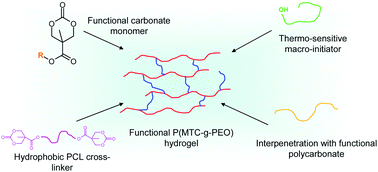Exploring the versatility of hydrogels derived from living organocatalytic ring-opening polymerization†
Abstract
In this work we have bridged the use of mild and living organocatalytic

* Corresponding authors
a
IBM Almaden Research Center, 650 Harry Road, San Jose, 95120 CA, USA
E-mail:
hedrick@almaden.ibm.com
b Department of Chemistry, Stanford University, Stanford, 94305 CA, USA
c Department of Chemistry, University of California, Berkeley, USA
d Department of Chemistry and Biochemistry, University of Oklahoma, Norman, 73069 OK, USA
e Department of Chemical Engineering, Stanford University, Stanford, USA
f
Center of Innovation and Research in Materials and Polymers, Laboratory of Polymeric and Composite Materials, 20, Place du Parc, 7000 Mons, Belgium
E-mail:
laetitia.mespouille@umons.ac.be
Fax: +003265373484
Tel: +003265373482
In this work we have bridged the use of mild and living organocatalytic

 Please wait while we load your content...
Something went wrong. Try again?
Please wait while we load your content...
Something went wrong. Try again?
F. Nederberg, V. Trang, R. C. Pratt, S. Kim, J. Colson, A. Nelson, C. W. Frank, J. L. Hedrick, P. Dubois and L. Mespouille, Soft Matter, 2010, 6, 2006 DOI: 10.1039/B920216A
To request permission to reproduce material from this article, please go to the Copyright Clearance Center request page.
If you are an author contributing to an RSC publication, you do not need to request permission provided correct acknowledgement is given.
If you are the author of this article, you do not need to request permission to reproduce figures and diagrams provided correct acknowledgement is given. If you want to reproduce the whole article in a third-party publication (excluding your thesis/dissertation for which permission is not required) please go to the Copyright Clearance Center request page.
Read more about how to correctly acknowledge RSC content.
 Fetching data from CrossRef.
Fetching data from CrossRef.
This may take some time to load.
Loading related content
